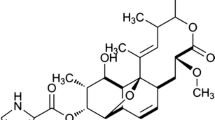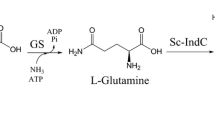Abstract
Violacein (Vio) is an important purple pigment with many potential bioactivities. Deoxyviolacein, a structural analog of Vio, is always synthesized in low concentrations with Vio in wild-type bacteria. Due to deoxyviolacein’s low production and difficulties in isolation and purification, little has been learned regarding its function and potential applications. This study was the first effort in developing a stable and efficient biosynthetic system for producing pure deoxyviolacein. A recombinant plasmid with vioabce genes was constructed by splicing using an overlapping extension-polymerase chain reaction, based on the Vio-synthesizing gene cluster of vioabcde, originating from Duganella sp. B2, and was introduced into Citrobacter freundii. With the viod gene disrupted in the Vio synthetic pathway, Vio production was completely abolished and the recombinant C. freundii synthesized only deoxyviolacein. Interestingly, vioe gene expression was strongly stimulated in the viod-deleted recombinant strain, indicating that viod disruptions could potentially induce polar effects upon the downstream vioe gene within this small operon. Deoxyviolacein production by this strain reached 1.9 g/L in shaker flasks. The product exhibited significant acid/alkali and UV resistance as well as significant inhibition of hepatocellular carcinoma cell proliferation at low concentrations of 0.1–1 μM. These physical characteristics and antitumor activities of deoxyviolacein contribute to illuminating its potential applications.






Similar content being viewed by others
References
Ahmed AM, Shimamoto T (2008) Emergence of a cefepime- and cefpirome-resistant Citrobacter freundii clinical isolate harbouring a novel chromosomally encoded AmpC beta-lactamase, CMY-37. International Journal of Antimicrobial Agents 32(3):256–261
Andrighetti-Frohner CR, Antonio RV, Creczynski-Pasa TB, Barardi CR, Simoes CM (2003) Cytotoxicity and potential antiviral evaluation of violacein produced by Chromobacterium violaceum. Mem Inst Oswaldo Cruz 98(6):843–848
Antonio RV, Creczynski-Pasa TB (2004) Genetic analysis of violacein biosynthesis by Chromobacterium violaceum. Genet Mol Res 3(1):85–91
Antonisamy P, Ignacimuthu S (2010) Immunomodulatory, analgesic and antipyretic effects of violacein isolated from Chromobacterium violaceum. Phytomedicine 17(3–4):300–304
Antonisamy P, Kannan P, Ignacimuthu S (2009) Anti-diarrhoeal and ulcer-protective effects of violacein isolated from Chromobacterium violaceum in Wistar rats. Fundam Clin Pharmacol 23(4):483–490
Asamizu S, Igarashi Y, Onaka H (2007) VioE, a prodeoxyviolacein synthase involved in violacein biosynthesis, is responsible for intramolecular indole rearrangement. Tetrahedron Letters 48:2923–2926
Balibar CJ, Walsh CT (2006) In vitro biosynthesis of violacein from L-tryptophan by the enzymes VioA-E from Chromobacterium violaceum. Biochemistry 45(51):15444–15457
Becker MH, Brucker RM, Schwantes CR, Harris RN, Minbiole KP (2009) The bacterially produced metabolite violacein is associated with survival of amphibians infected with a lethal fungus. Appl Environ Microbiol 75(21):6635–6638
Bromberg N, Justo GZ, Haun M, Duran N, Ferreira CV (2005) Violacein cytotoxicity on human blood lymphocytes and effect on phosphatases. J Enzyme Inhib Med Chem 20(5):449–454
Carmichael J, DeGraff WG, Gazdar AF, Minna JD, Mitchell JB (1987) Evaluation of a tetrazolium-based semiautomated colorimetric assay: assessment of radiosensitivity. Cancer Res 47(4):943–946
Cazoto LL, Martins D, Ribeiro MG, Duran N, Nakazato G (2011) Antibacterial activity of violacein against Staphylococcus aureus isolated from Bovine mastitis. J Antibiot (Tokyo) 64(5):395–397
Durán N, Antonio RV, Haun M, Pilli RA (1994) Biosynthesis of a trypanocide by Chromobacterium violaceum. World J Microbiol Biotechnol V10(6):686–690
Duran N, Justo GZ, Ferreira CV, Melo PS, Cordi L, Martins D (2007) Violacein: properties and biological activities. Biotechnol Appl Biochem 48(Pt 3):127–133
Ferreira CV, Bos CL, Versteeg HH, Justo GZ, Duran N, Peppelenbosch MP (2004) Molecular mechanism of violacein-mediated human leukemia cell death. Blood 104(5):1459–1464
Jiang PX, Wang HS, Zhang C, Lou K, Xing XH (2010) Reconstruction of the violacein biosynthetic pathway from Duganella sp. B2 in different heterologous hosts. Appl Microbiol Biotechnol 86(4):1077–1088
Konzen M, De Marco D, Cordova CA, Vieira TO, Antonio RV, Creczynski-Pasa TB (2006) Antioxidant properties of violacein: possible relation on its biological function. Bioorg Med Chem 14(24):8307–8313
Kuwayama H, Obara S, Morio T, Katoh M, Urushihara H, Tanaka Y (2002) PCR-mediated generation of a gene disruption construct without the use of DNA ligase and plasmid vectors. Nucleic Acids Res 30(2):E2
Matz C, Webb JS, Schupp PJ, Phang SY, Penesyan A, Egan S, Steinberg P, Kjelleberg S (2008) Marine biofilm bacteria evade eukaryotic predation by targeted chemical defense. PLoS ONE 3(7):e2744
Momen AZ, Hoshino T (2000) Biosynthesis of violacein: intact incorporation of the tryptophan molecule on the oxindole side, with intramolecular rearrangement of the indole ring on the 5-hydroxyindole side. Biosci Biotechnol Biochem 64(3):539–549
Morohoshi T, Fukamachi K, Kato M, Kato N, Ikeda T (2010) Regulation of the violacein biosynthetic gene cluster by acylhomoserine lactone-mediated quorum sensing in Chromobacterium violaceum ATCC 12472. Biosci Biotechnol Biochem 74(10):2116–2119
Nakamura Y, Sawada T (2003) Production of antibacterial violet pigment by psychrotropic bacterium RT102 strain. Biotechnology and Bioprocess Engineering 8:37–40
Nakamura Y, Morita Y, Tamiya E (2002) Isolation of a psychrotrophic bacterium from the organic residue of a water tank keeping rainbow trout and antibacterial effect of violet pigment produced from the strain. Biochemical Engineering Journal 12:79–86
Ryan KS, Drennan CL (2009) Divergent pathways in the biosynthesis of bisindole natural products. Chem Biol 16(4):351–364
Ryan KS, Balibar CJ, Turo KE, Walsh CT, Drennan CL (2008) The violacein biosynthetic enzyme VioE shares a fold with lipoprotein transporter proteins. J Biol Chem 283(10):6467–6475
Sanchez C, Brana AF, Mendez C, Salas JA (2006) Reevaluation of the violacein biosynthetic pathway and its relationship to indolocarbazole biosynthesis. Chembiochem 7(8):1231–1240
Shinoda K, Hasegawa T, Sato H, Shinozaki M, Kuramoto H, Takamiya Y, Sato T, Nikaidou N, Watanabe T, Hoshino T (2007) Biosynthesis of violacein: a genuine intermediate, protoviolaceinic acid, produced by VioABDE, and insight into VioC function. Chem Commun (Camb)(40):4140–4142
Smits TH, Seeger MA, Witholt B, van Beilen JB (2001) New alkane-responsive expression vectors for Escherichia coli and pseudomonas. Plasmid 46(1):16–24
Srinivasan V, Nam HM, Sawant AA, Headrick SI, Nguyen LT, Oliver SP (2008) Distribution of tetracycline and streptomycin resistance genes and class 1 integrons in Enterobacteriaceae isolated from dairy and nondairy farm soils. Microbial Ecology 55(2):184–193
Tsutomu H, Takeo U, Nagahiro O (1987) Biosynthesis of violacein: a novel rearrangement in tryptophan metabolism with a 1, 2-shift of the indole ring. Agricultural and Biological Chemistry 51:965–996
Wang HS, Jiang PX, Lu Y, Ruan ZY, Jiang RB, Xing XH, Lou K, Wei D (2009) Optimization of culture conditions for violacein production by a new strain of Duganella sp B2. Biochemical Engineering Journal 44(2–3):119–124
Acknowledgments
This work was supported in part by the National Science Fund of China (Grant no. 21006058), a China Postdoctoral Science Foundation funded project (Grant no. 20080430367), a Basic Research Fund of CAAS (0042009001), and a Xinjiang-supporting project by Science and Technology (Grant no. 200991132).
Author information
Authors and Affiliations
Corresponding author
Electronic supplementary material
Below is the link to the electronic supplementary material.
ESM 1
(DOCX 1028 kb)
Rights and permissions
About this article
Cite this article
Jiang, Px., Wang, Hs., Xiao, S. et al. Pathway redesign for deoxyviolacein biosynthesis in Citrobacter freundii and characterization of this pigment. Appl Microbiol Biotechnol 94, 1521–1532 (2012). https://doi.org/10.1007/s00253-012-3960-0
Received:
Revised:
Accepted:
Published:
Issue Date:
DOI: https://doi.org/10.1007/s00253-012-3960-0




